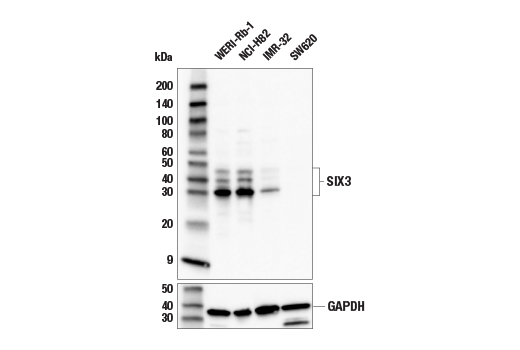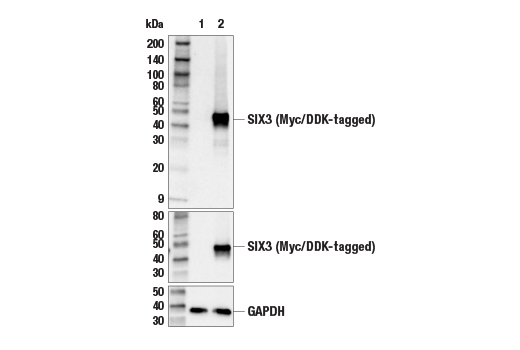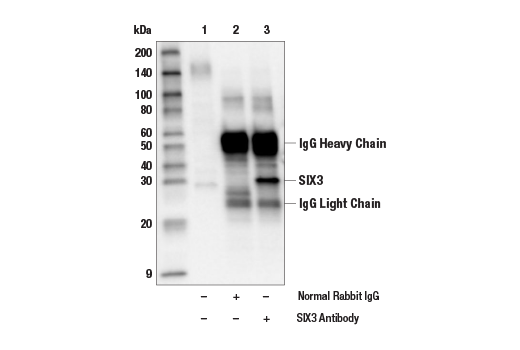WB, IP
H
Endogenous
30, 38, 45
Rabbit
#O95343
6496
Product Information
Product Usage Information
| Application | Dilution |
|---|---|
| Western Blotting | 1:1000 |
| Immunoprecipitation | 1:50 |
Storage
Specificity / Sensitivity
Species Reactivity:
Human
Source / Purification
Polyclonal antibodies are produced by immunizing animals with a synthetic peptide corresponding to residues surrounding Arg281 of human SIX3 protein. Antibodies are purified by peptide affinity chromatography.
Background
Sine oculis homeobox (SIX) proteins belong to a family of evolutionarily conserved transcription factors discovered in Drosophila mutant screens for embryonic eye development genes (1-3). The prototypical family member (sine oculis, so) was named for eyeless embryos carrying mutations in a gene highly conserved among vertebrates, including humans (SIX1) (4). A total of six family members (SIX1-6) have been identified in vertebrates. Each SIX protein contains a homeobox nucleic acid recognition domain (HD) with a DNA-binding helix-turn-helix motif and an adjacent SIX domain, which may be involved in regulating protein-protein interactions (5). In addition to their critical functions during embryonic organogenesis, research studies suggest that SIX proteins play additional roles in postnatal cell cycle regulation, with potentially important implications in tumorigenesis (6,7). In addition to its well-established role within gene networks regulating neural patterning and brain development (8,9), SIX3 was more recently reported to regulate postnatal pancreatic β cell maturation, in part by suppressing the expression of genes associate with fetal β cells and various non-β cell types (10,11). Dysregulated expression of SIX3 has also been linked with tumor development. For example, in a study of cell free DNA isolated from plasma, SIX3 was identified as a differentially methylated gene that was diagnostically relevant for patients with pancreatic ductal adenocarcinoma (12). This finding was consistent with earlier reports supporting a role for SIX3 as a tumor suppressor (13-15).
- Kumar, J.P. (2009) Cell Mol Life Sci 66, 565-83.
- Fischbach, K.F. and Technau, G. (1984) Dev Biol 104, 219-39.
- Fischbach, K.F. and Heisenberg, M. (1981) Proc Natl Acad Sci U S A 78, 1105-9.
- Boucher, C.A. et al. (1996) Genomics 33, 140-2.
- Pignoni, F. et al. (1997) Cell 91, 881-91.
- Ford, H.L. et al. (1998) Proc Natl Acad Sci U S A 95, 12608-13.
- Coletta, R.D. et al. (2004) Proc Natl Acad Sci U S A 101, 6478-83.
- Wallis, D.E. and Muenke, M. (1999) Mol Genet Metab 68, 126-38.
- Oliver, G. and Gruss, P. (1997) Trends Neurosci 20, 415-21.
- Arda, H.E. et al. (2016) Cell Metab 23, 909-20.
- Bevacqua, R.J. et al. (2021) Genes Dev 35, 234-249.
- Li, S. et al. (2020) Front Genet 11, 596078.
- Yu, Z. et al. (2017) J Hematol Oncol 10, 115.
- Zhang, B. et al. (2017) J Neurooncol 133, 509-518.
- Zheng, Y. et al. (2018) Theranostics 8, 972-989.
Species Reactivity
Species reactivity is determined by testing in at least one approved application (e.g., western blot).
Western Blot Buffer
IMPORTANT: For western blots, incubate membrane with diluted primary antibody in 5% w/v BSA, 1X TBS, 0.1% Tween® 20 at 4°C with gentle shaking, overnight.
Applications Key
WB: Western Blotting IP: Immunoprecipitation
Cross-Reactivity Key
H: human M: mouse R: rat Hm: hamster Mk: monkey Vir: virus Mi: mink C: chicken Dm: D. melanogaster X: Xenopus Z: zebrafish B: bovine Dg: dog Pg: pig Sc: S. cerevisiae Ce: C. elegans Hr: horse GP: Guinea Pig Rab: rabbit All: all species expected
Trademarks and Patents
Limited Uses
Except as otherwise expressly agreed in a writing signed by a legally authorized representative of CST, the following terms apply to Products provided by CST, its affiliates or its distributors. Any Customer's terms and conditions that are in addition to, or different from, those contained herein, unless separately accepted in writing by a legally authorized representative of CST, are rejected and are of no force or effect.
Products are labeled with For Research Use Only or a similar labeling statement and have not been approved, cleared, or licensed by the FDA or other regulatory foreign or domestic entity, for any purpose. Customer shall not use any Product for any diagnostic or therapeutic purpose, or otherwise in any manner that conflicts with its labeling statement. Products sold or licensed by CST are provided for Customer as the end-user and solely for research and development uses. Any use of Product for diagnostic, prophylactic or therapeutic purposes, or any purchase of Product for resale (alone or as a component) or other commercial purpose, requires a separate license from CST. Customer shall (a) not sell, license, loan, donate or otherwise transfer or make available any Product to any third party, whether alone or in combination with other materials, or use the Products to manufacture any commercial products, (b) not copy, modify, reverse engineer, decompile, disassemble or otherwise attempt to discover the underlying structure or technology of the Products, or use the Products for the purpose of developing any products or services that would compete with CST products or services, (c) not alter or remove from the Products any trademarks, trade names, logos, patent or copyright notices or markings, (d) use the Products solely in accordance with CST Product Terms of Sale and any applicable documentation, and (e) comply with any license, terms of service or similar agreement with respect to any third party products or services used by Customer in connection with the Products.


